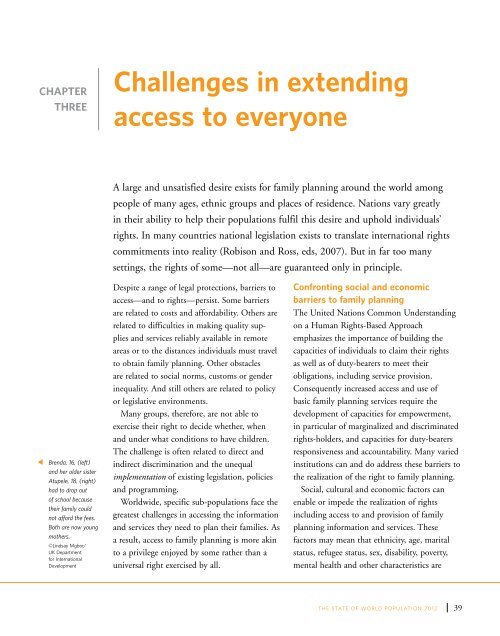State of World Population 2012 - Country Page List - UNFPA
State of World Population 2012 - Country Page List - UNFPA
State of World Population 2012 - Country Page List - UNFPA
Create successful ePaper yourself
Turn your PDF publications into a flip-book with our unique Google optimized e-Paper software.
CHAPTER<br />
THREE<br />
Challenges in extending<br />
access to everyone<br />
A large and unsatisfied desire exists for family planning around the world among<br />
people <strong>of</strong> many ages, ethnic groups and places <strong>of</strong> residence. Nations vary greatly<br />
in their ability to help their populations fulfil this desire and uphold individuals’<br />
rights. In many countries national legislation exists to translate international rights<br />
commitments into reality (Robison and Ross, eds, 2007). But in far too many<br />
settings, the rights <strong>of</strong> some—not all—are guaranteed only in principle.<br />
t<br />
Brenda, 16, (left)<br />
and her older sister<br />
Atupele, 18, (right)<br />
had to drop out<br />
<strong>of</strong> school because<br />
their family could<br />
not afford the fees.<br />
Both are now young<br />
mothers.<br />
©Lindsay Mgbor/<br />
UK Department<br />
for International<br />
Development<br />
Despite a range <strong>of</strong> legal protections, barriers to<br />
access—and to rights—persist. Some barriers<br />
are related to costs and affordability. Others are<br />
related to difficulties in making quality supplies<br />
and services reliably available in remote<br />
areas or to the distances individuals must travel<br />
to obtain family planning. Other obstacles<br />
are related to social norms, customs or gender<br />
inequality. And still others are related to policy<br />
or legislative environments.<br />
Many groups, therefore, are not able to<br />
exercise their right to decide whether, when<br />
and under what conditions to have children.<br />
The challenge is <strong>of</strong>ten related to direct and<br />
indirect discrimination and the unequal<br />
implementation <strong>of</strong> existing legislation, policies<br />
and programming.<br />
<strong>World</strong>wide, specific sub-populations face the<br />
greatest challenges in accessing the information<br />
and services they need to plan their families. As<br />
a result, access to family planning is more akin<br />
to a privilege enjoyed by some rather than a<br />
universal right exercised by all.<br />
Confronting social and economic<br />
barriers to family planning<br />
The United Nations Common Understanding<br />
on a Human Rights-Based Approach<br />
emphasizes the importance <strong>of</strong> building the<br />
capacities <strong>of</strong> individuals to claim their rights<br />
as well as <strong>of</strong> duty-bearers to meet their<br />
obligations, including service provision.<br />
Consequently increased access and use <strong>of</strong><br />
basic family planning services require the<br />
development <strong>of</strong> capacities for empowerment,<br />
in particular <strong>of</strong> marginalized and discriminated<br />
rights-holders, and capacities for duty-bearers<br />
responsiveness and accountability. Many varied<br />
institutions can and do address these barriers to<br />
the realization <strong>of</strong> the right to family planning.<br />
Social, cultural and economic factors can<br />
enable or impede the realization <strong>of</strong> rights<br />
including access to and provision <strong>of</strong> family<br />
planning information and services. These<br />
factors may mean that ethnicity, age, marital<br />
status, refugee status, sex, disability, poverty,<br />
mental health and other characteristics are<br />
THE STATE OF WORLD POPULATION <strong>2012</strong><br />
39
















